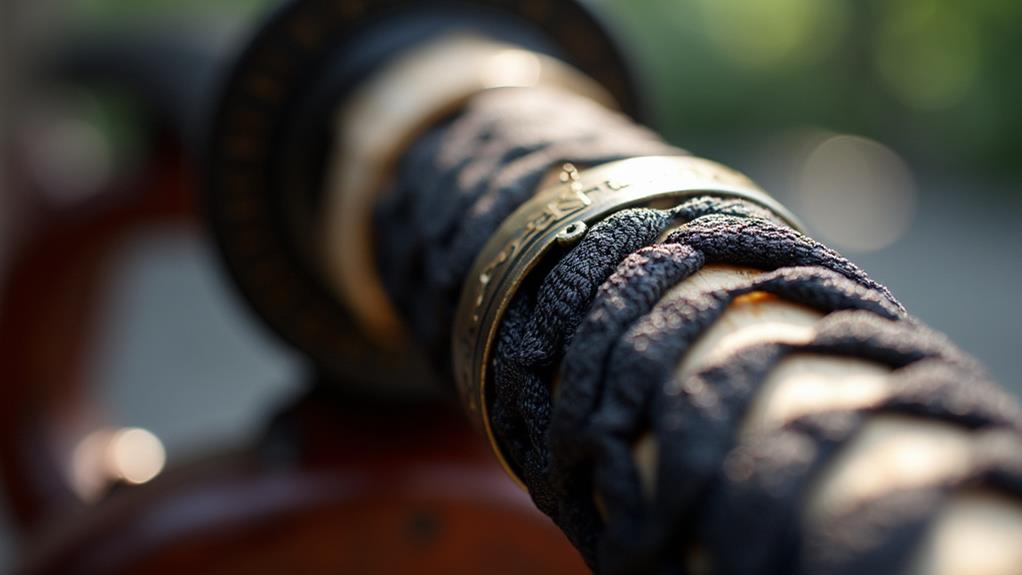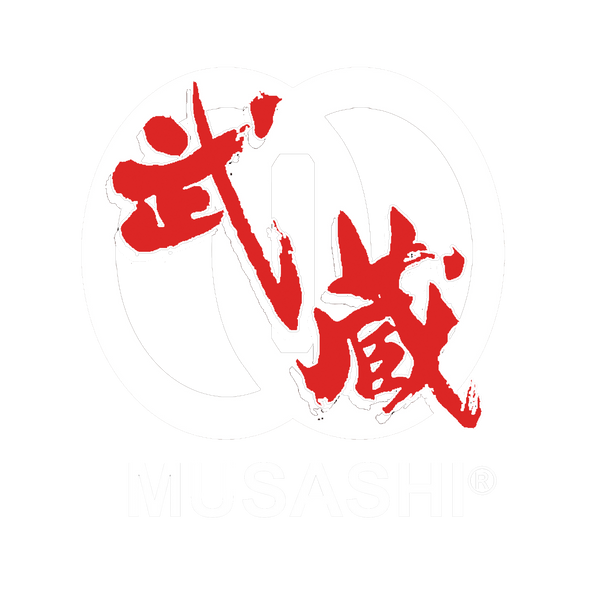
Evaluating the Quality of a Katana's Tsuka (Handle)
Share
To evaluate the quality of a katana's tsuka, focus on a few key aspects. Check the ito wrapping; it should be tight and even for a secure grip. Look at the materials used, like durable hardwood and genuine samegawa, which enhance comfort and control. Confirm components, such as the fuchi and mekugi, align properly. Ultimately, assess the tsuka-maki; a skilled wrapping pattern reflects craftsmanship and attention to detail. A quality tsuka not only guarantees performance but also enhances safety. Discovering the subtleties of these features will help you appreciate the craftsmanship even more.
Key Takeaways
- Check the tightness and uniformity of the tsuka-ito wrapping for grip stability and control.
- Ensure proper alignment of components, particularly fuchi and mekugi, for structural integrity.
- Evaluate the materials used, favoring high-quality hardwood and genuine samegawa for durability.
- Inspect the tsuka-maki pattern for craftsmanship and attention to detail in wrapping technique.
- Look for visible hamon, reflecting the sword's artistic history and quality craftsmanship.
Understanding Katana Tsuka
When considering the intricacies of a katana, understanding the tsuka, or handle, is indispensable. The tsuka is more than just a grip; it's a critical component that connects you to the soul of the traditional Japanese sword.
A katana requires a handle that not only feels right in your hands but also offers perfect balance when wielded. The tsuka features components such as tsuka-ito wrapping material and samegawa (ray skin) underneath, which directly contribute to grip and shock absorption, making it a pivotal aspect of the sword's design.

The usage of real ray skin, or same, is a hallmark of quality in a katana's tsuka. This material provides a unique texture for added grip, guaranteeing that you feel in control during any practice or performance. The handle wrapping, typically done with silk or cotton, enhances this connection further, allowing you to forge a bond with the weapon.
As you explore different katanas, pay close attention to the tsuka. Check how the real ray skin is wrapped and make sure it feels comfortable. This detail will deeply influence your experience and help you grow in your journey with the katana. After all, a perfectly balanced tsuka opens the door to greater mastery, allowing you to belong to the rich tradition of katana craftsmanship.
Key Parts of the Tsuka
The tsuka of a katana comprises several key parts that contribute to its functionality and aesthetic appeal. Understanding the craftsmanship behind each element is crucial for appreciating your katana fully. At the base of the handle, the Fuchi acts as a metal ring, supporting the blade's structure while hiding any imperfections in the handle.
Wrapped around the handle, the Tsuka-Ito, usually made from cotton or silk, provides a comfortable grip and enhances the beautiful look of the katana. The texture of the Samegawa, or ray skin, further improves grip, ensuring that you maintain control over your sword, whether you're showcasing its cutting edge or practicing your strikes. For ideal care, refer to the effective cleaning and care practices to keep these elements in pristine condition.
To secure the tsuka to the tang, wooden pegs called Mekugi are used, ensuring that the handle remains firmly anchored during use. This connection is indispensable, as a stable handle supports effective movements and technique. Additionally, Menuki, the small metal ornaments embedded in the handle, offer a personal touch, showcasing your unique taste while also providing functional enhancements. Together, these components not only serve practical purposes but also celebrate the rich Japanese tradition of sword-making and Clay Tempering, ensuring that your katana feels like an extension of yourself.
Tsuka Design Variations
Tsuka design variations reflect the diverse needs and preferences of katana users throughout history. Each design serves a unique purpose, allowing you to find the perfect fit for your style. For instance, the Tachi Tsuka (Morozori) has a curved design ideal for horseback riding, transitioning smoothly from blade to end. This design enhances the katana's overall balance and performance, making it suitable for swift movements.
If you're looking for a more gentle curve, Narabi-sori/Haichi might appeal to you, with its subtle shape on the back edge.

If you prefer a shorter blade, the Chu-Kissaki Tsuka offers a more pronounced curve that complements that length. On the other hand, the Hirazukuri Tsuka provides a flat, functional design that gets the job done without extra flair. The ergonomic grip provided by the hilt's design guarantees that the katana is both comfortable and effective in action.
For those who admire a bit of aggression in their grip, the Yamazukuri Tsuka's angular shape is captivating.
No matter what style you choose, make sure that the tsuka fits snugly around the tang. A good katana, crafted from spring steel through a meticulous hardening process, becomes not just a weapon but a work of art, allowing for powerful and precise movements as you wield it.
Materials Used in Tsuka
Crafted with care, the materials used in a katana's tsuka play a crucial role in its functionality and aesthetic appeal. You'll often find that the tsuka-shitaji, or handle body, is made from durable magnolia wood. This choice guarantees hardness and water resistance, making it ideal for a reliable grip.
The surface of the tsuka is commonly wrapped in ray skin, known as samegawa. This material is valued for its robust texture and resilience, especially when it features larger, more uniform grains. Tightly wound over the samegawa is the ito, which can be made from silk or cotton. This ito-maki, or cord wrapping, not only enhances grip but also adds a decorative flair that reflects the katana's unique character.
Metal components like the menuki—ornamental fittings—along with the habaki (blade collar), help secure and elevate the overall design of the tsuka. Each material used in the construction of the katana's handle contributes to a deeper connection with the sword. Choosing a katana with quality materials means selecting a piece that's not just a weapon but a work of art to cherish and pass on.
Importance of Secure Wrapping
When wielding a katana, having a securely wrapped tsuka is indispensable for your safety and effectiveness. A tightly wrapped handle not only gives you a solid grip but guarantees the katana sword remains stable during intense movements. This increases your cutting power and overall control, as you confidently navigate the complexities of the fight.

The process of tsuka-maki, especially using techniques like Katate Maki, is pivotal. It adds to the balance and enhances your connection to the weapon. Poor wrapping can lead to dangerous slips, threatening both you and the structure of the steel.
| Aspect | Importance |
|---|---|
| Grip Stability | Prevents slipping during use |
| Balance | Enhances control in dynamic movements |
| Safety | Reduces risk of the handle detaching (Nakago) |
| Performance | Increases sharpness and durability |
| Craftsmanship | Reflects meticulous care in making a quality tsuka |
Evaluating Tsuka Quality
A katana's performance hinges decisively on the quality of its tsuka. When you evaluate a tsuka, pay close attention to the wrapping of the Ito (cord). It should be tight and even, offering a secure grip that feels comfortable in your hand. Examine the alignment of components like the Fuchi (metal ring) and Mekugi (wooden pegs). Proper alignment safeguards the katana's structural integrity, which is vital for safe use.
Next, consider the materials used. A high-quality hardwood for the Tsuka-shitaji (handle body) and genuine Samegawa (ray skin) show the craftsmanship behind these Japanese swords. Investigate the Tsuka-Maki (handle wrapping) pattern, its tension, and finish. These details reflect the swordsmith's skill and expertise.
A well-crafted tsuka enables a balanced and responsive feel, allowing you to harness the katana's hard edge with precision. As you wield the blade, notice how the hamon is the visible artistry that speaks to the katana's history. Understanding these hamon patterns enriches your connection to this art form, bringing you closer to the tradition of swords made in Japan.
Frequently Asked Questions
What to Look for in a Good Katana?
When seeking a good katana, examine the blade quality for cutting performance, assess balance and weight, appreciate decorative elements and historical significance, and consider maintenance requirements and collectible value for a meaningful connection to tradition.
What Is the Best Handle Material for a Katana?
When choosing the best handle material for your katana, prioritize handle durability and firmness for a reliable grip. Consider handle aesthetics and texture for comfort and weight, while customization options enhance both style and functionality.
The Material of the Tsuka on a Katana
The tsuka's material impacts your katana's tightness of grip, ergonomic comfort, and overall workmanship. Opt for durable, traditional elements that offer aesthetic appeal and ease of maintenance; consider replacement options to keep it in prime condition.
What Are the Grades of Katana Steel?
When considering katana steel grades, you'll notice carbon content affects hardness and aesthetics. The forging technique and tempering process, alongside differential hardening, contribute to blade geometry, while sword polish reveals any metallurgical impurities present.
Conclusion
When evaluating a katana's tsuka, you want to focus on key aspects like materials, design, and secure wrapping. A well-crafted tsuka not only feels good in your grip but also enhances your control and overall experience. Don't overlook the details, as they can make a big difference in both quality and performance. By keeping these factors in mind, you can confidently choose a katana that meets your needs and expectations. Musashi Swords offers a range of katanas with high-quality tsukas, allowing enthusiasts to experience the craftsmanship firsthand.
